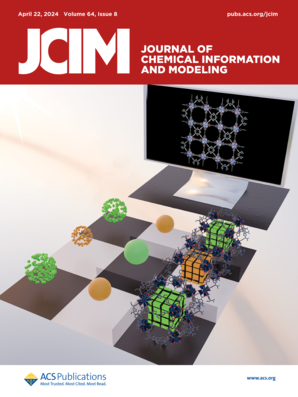Integrating Chemo- and Bioinformatics with In Vitro Biological Assays to Discover Potential ACE2 and Mpro Inhibitors against SARS-CoV-2.
IF 5.6
2区 化学
Q1 CHEMISTRY, MEDICINAL
引用次数: 0
Abstract
The study aims to identify potential SARS-CoV-2 inhibitors and investigate the mechanism of action on the viral ACE2 receptor and main protease (Mpro), using chemo- and bioinformatics approaches. Ligand-based virtual screening was performed in the Molport database (∼4.79 million compounds), and after applying physicochemical filters, 313 molecules with characteristics such as hydroxychloroquine were obtained. After obtaining bioactive conformations, the molecular structures were subjected to the study of pharmacokinetic predictions, in which 106 molecules presented properties for oral bioavailability, penetration of the BBB, PPB, and solubility (average). The toxicological property predictions proved plausible for the molecules, as they did not present warnings of hepatotoxicity, mutagenicity, potential risk of carcinogenicity, and LC50 and LD50 values higher than the controls. Subsequently, 81 structures were subjected to a molecular docking study of ACE2 receptor/Spike and Mpro. In the ACE2 receptor, four (4) ligands showed high binding affinity value, in which the molecule MolPort-010-778-422 had the best ΔG value of -9.414 kcal/mol, followed by MolPort-009-093-282 with ΔG = -8.978 kcal/mol. In the Mpro receptor, four (4) ligands showed high binding affinity values compared to control 11b, with emphasis on molecule MolPort-005-766-143 with ΔG = -8.829 kcal/mol, followed by molecule MolPort-046-186-743. To study the antiviral effects of the molecules in vitro, TopHits8 molecules were tested against the SARS-CoV-2 virus. MolPort-010-778-422 had the best result on the screening and presented an IC50 of 8.9 nM.将化学和生物信息学与体外生物测定相结合,发现抗SARS-CoV-2的潜在ACE2和Mpro抑制剂
本研究旨在利用化学和生物信息学方法,鉴定潜在的SARS-CoV-2抑制剂,并研究其对病毒ACE2受体和主要蛋白酶(Mpro)的作用机制。在Molport数据库(约479万个化合物)中进行了基于配体的虚拟筛选,在应用物理化学过滤器后,获得了313个具有羟氯喹等特征的分子。获得生物活性构象后,对分子结构进行药代动力学预测研究,其中106个分子具有口服生物利用度、血脑屏障渗透、PPB和溶解度(平均)的特性。这些分子的毒理学特性预测被证明是合理的,因为它们没有出现肝毒性、诱变性、潜在致癌性风险的警告,并且LC50和LD50值高于对照组。随后,81个结构进行了ACE2受体/Spike和Mpro的分子对接研究。在ACE2受体中,有4种配体表现出较高的结合亲和力,其中分子MolPort-010-778-422的ΔG值最好,为-9.414 kcal/mol,其次是MolPort-009-093-282, ΔG = -8.978 kcal/mol。在Mpro受体中,与对照11b相比,有4个配体表现出较高的结合亲和力,其中以分子MolPort-005-766-143 (ΔG = -8.829 kcal/mol)为重点,其次是分子MolPort-046-186-743。为了研究这些分子在体外的抗病毒作用,我们对TopHits8分子对SARS-CoV-2病毒进行了检测。MolPort-010-778-422的筛选效果最好,IC50为8.9 nM。
本文章由计算机程序翻译,如有差异,请以英文原文为准。
求助全文
约1分钟内获得全文
求助全文
来源期刊
CiteScore
9.80
自引率
10.70%
发文量
529
审稿时长
1.4 months
期刊介绍:
The Journal of Chemical Information and Modeling publishes papers reporting new methodology and/or important applications in the fields of chemical informatics and molecular modeling. Specific topics include the representation and computer-based searching of chemical databases, molecular modeling, computer-aided molecular design of new materials, catalysts, or ligands, development of new computational methods or efficient algorithms for chemical software, and biopharmaceutical chemistry including analyses of biological activity and other issues related to drug discovery.
Astute chemists, computer scientists, and information specialists look to this monthly’s insightful research studies, programming innovations, and software reviews to keep current with advances in this integral, multidisciplinary field.
As a subscriber you’ll stay abreast of database search systems, use of graph theory in chemical problems, substructure search systems, pattern recognition and clustering, analysis of chemical and physical data, molecular modeling, graphics and natural language interfaces, bibliometric and citation analysis, and synthesis design and reactions databases.

 求助内容:
求助内容: 应助结果提醒方式:
应助结果提醒方式:


